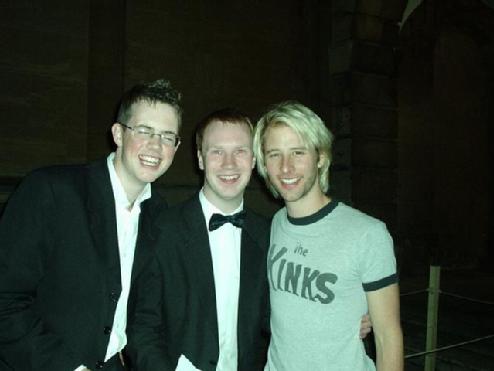Andrew Crichton
After getting my M.Phys. at the University of Oxford, and working in a bank for a year, I decided to do a Ph.D. with the Superconductivity and Magnetism Group under the supervision of Prof. Don Paul. My research mainly consists of investigating the vortex lattices in type II superconductors. Unlike type I superconductors, type II materials allow magnetic flux to penetrate the sample. Abrikosov, in 1957, published a paper that showed that magnetic flux quanta formed a periodic lattice. Considering only nearest neighbour interactions, this lattice is hexagonal in shape. This arises due to the fact the quanta repel each other due to the Lorentz force. In fact in his publication, Abrikosov made a numerical error to show that a square lattice lattice would form with a lower free energy than the hexagonal one. This was quickly rectified by Kleiner, Roth and Autler. The difference in the free energy of the square and hexagonal lattices is only about (1.18/1.16) 2%. In nature, the hexagonal lattice is rarely seen.
The phase diagram of a type II superconductor consists of the Meissner state, and the mixed (Abrikosov) state. This phase may itself, be broken down into individual phases of the mixed state. These can be a Bragg glasses, a rigid vortex lattice or a vortex liquid. This is due to the fact that other interactions need to be considered. These interactions arise from (i) non-local corrections coupled with Fermi surface anisotropy, (ii) anisotropy of the effective mass, (iii) asymmetry in the superconducting gap. These interactions play a role in the vortex lattice phase transitions and may mean that only a small amount of energy is required to change the morphology of the flux line lattice.
The vortex lattice, by its very definition, is an ordered modulating array of magnetic flux. These can be investigated, quite elegantly, by taking advantage of the fact that a neutron has no electric charge (it can penetrate a long way into a sample) and a magnetic dipole moment (udd - quarks). This means that a beam of neutrons 'sees' a periodic magnetic potential and can therefore be scattered coherently off the lattice forming a diffraction pattern. We have performed experiments on CaC6(intercalated graphite), CaRh4Sn13, La3Co4Sn13and high Tc BiSCCO using the D22 (Small Angle Neutron Scattering) diffractometer at the Institut Laue-Langevin in Grenoble. We also looked at the phonon dispersion curves of these superconductors using inelastic neutron scattering techniques. We have also used neutrons to investigate the diffraction patterns and dispersion curves of magnons in CrB2 at the ISIS neutron spallation source in the Rutherford-Appleton Laboratory in Chilton, Oxfordshire.
Training at Warwick starts with the logical step of sample preparation. We use our arc-furnace and optical floating zone furnaces to produce high quality single crystals of some of the samples required for these studies. The crystallographic quality of the samples has been checked by our Laue X-ray diffractometer. We characterise the samples using our Vibrating Sample and SQUID magnetometers, and our Quantum Design PPMS (heat capacity and resistivity measurements). Part of my training also involved attending the ISIS Neutron Training Course in February 2006.
Being a student at Warwick is a privilege. There is a great team atmosphere which I am proud to be a part of!!!
Please see:
and
http://www.grahamcrichton.com/

Write to
Andrew Crichton
Department of Physics
University of Warwick
Coventry CV4 7AL
United Kingdom
